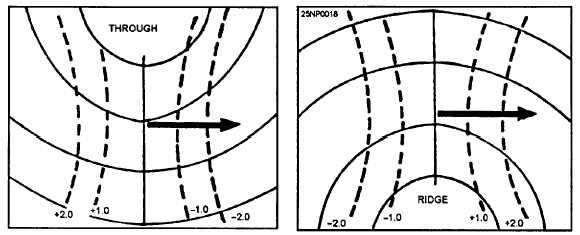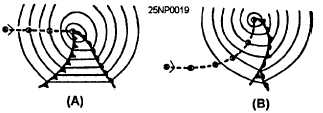Figure 3-5.-Movement of troughs and ridges in relation to the isallobaric gradient.
Steering
Surface pressure systems move with the upper-level
steering current. his principle is based on the concept
that pressure systems are moved by the external forces
operating on them. Thus, a surface pressure system
tends to be steered by the isotherms, contour lines, or
streamlines aloft, by the warm sector isobars, or by the
orientation of a warm front. This principle is nearly
always applied to the relationship between the velocity
of a cyclone and the velocity of the basic flow in which
it is embedded.
The method works best when the flow pattern
changes very slowly, or not at all. If the upper flow
pattern is expected to change greatly during the forecast
period, you must first forecast the change in this pattern
prior to forecasting the movement of the surface
pressure systems. Do not attempt to steer a surface
system by the flow of an upper level that has closed
contours above the surface system. When using the
steering method, you must first consider the systems that
are expected to have little or no movement; namely,
warm highs and cold lows. Then, consider movement
of migratory highs and lows; and finally, consider the
changes in the intensity of the systems.
Figure 3-6.-Movement of lows in relation to warm sector
isobars. (A) Movement of warm sector lows; (B) movement
of old occluded cyclones.
Studies that used the steering technique have found,
inmost cases, that there was a displacement of the lows
poleward and the highs equatorward of the steering
current.
Therefore, expect low-pressure centers,
especially those of large dimension, to be deflected to
the left and high-pressure areas deflected to the right of
a westerly steering current. Over North America the
angle of deflection averages about 15°, although
deviations range from 0° to 25° or even 30°.
CAUTION
The steering technique should not be
attempted unless the closed isallobaric
minimum is followed by a closed isallobaric
maximum some distance to the rear of the low.
THE STEERING CURRENT.— The steering
flow or current is the basic flow that exerts a strong
influence upon the direction and speed of movement of
disturbances embedded in it. The steering current or
layer is a level, or a combination of levels, in the
atmosphere that has a definite relationship to the
velocity of movement of the embedded lower level
circulations. The movement of surface systems by this
flow is the most direct application of the steering
technique. Normally, the level above the last closed
isobar is selected. This could be the 700-, 500-, or
300-hPa level. However, in practice, it is better to
integrate the steering principle over more than one level.
The levels most often used are the 700- and 500-hPa
levels.
For practical usage,
chart should be used in
the present 700- or 500-mb
conjunction with the 24- or
3-5



